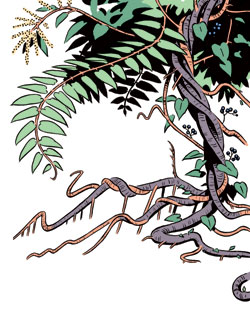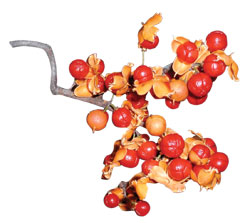
Spring! We salute you with Whitman open arms, proclaim buds soon to bloom. But not everything in the business of being reborn can be celebrated, or even trusted. Some imported plant species now growing in the Naked City biosphere are perfectly polite guests. But there are others, honeysuckles from Japan, the wetland Phragmites from Central Europe, the giant hogweed straight outta the Caucasus, the bamboo. These are the invasives, the aliens among the azaleas, the enemy within: trees, shrubs, and grasses that spread like body-snatching pods from the fifties horror picture, a cellulose fifth column for whom no niche is ever big enough.
The rise of the woody creeper invasive vine might not equal the environmental blood sport of a seventeen-foot-long python late of Burma (and suburban terrariums) duking it out with a 1,000-pound nativist alligator for supremacy of the Everglades’ food chain. But it is something you tend to notice since Hurricane Sandy reminded city dwellers that the natural world has more than a few tricks up its sleeve when it comes to rearranging the landscape. Besides, it isn’t like these encroachers are hard to see. Sun-worshippers, they cheekily flaunt their habitat-wrecking work out in the open, most prominently alongside bucolic thoroughfares like I-95 or the Saw Mill Parkway, where anyone can watch them choke the life from once-sturdy oaks, maples, and ash—good American trees all.
Once upon a time, plants bent on expansion had to depend on birds and wind to enlarge their realm. Now seeds come on boats, planes, or crushed up in the treads of truck wheels, though more often they are imported on purpose, with a bill of lading included. Consider the case of one of the killer vines, Oriental bittersweet (code name: Celastrus orbiculatus), which arrived in this country from Japan and Korea in the latter part of the nineteenth century at the behest of horticulturists who prized the vine as an “ornamental” owing to its pretty, summer-blooming red berries. The plant became a garden staple primarily in the northeastern U.S.—and then it “got out,” as botanists say, aggressively outcompeting the genetically similar but less fecund American bittersweet. Oriental bittersweet, which like many invasive species is still sold in nurseries across the country, now can be found curling around the trunks of local trees like a tourniquet. It also provides a latticework for one of its partners in enviro-crime, the multiflora rose, which first came to the U.S. from Korea and North China in 1866 and has been used extensively to prevent erosion thanks to its thickly bunched root system. A champ climber, the multiflora vaults toward the canopy, thereby shutting off light to surrounding native species with its voluminous foliage. The coup de grâce is often supplied by the notorious porcelainberry (Ampelopsis brevipedunculata), whose fancy pale-blue fruit look quite attractive as it engulfs wheezing evergreens with its tangled “hairnet of death.”
You don’t have to leave home to witness this monkey-wrenching of natural selection. I’ve got plenty of invasive plants right here in my Brooklyn backyard. I’ve got the English ivy (Hedera helix, really from around the Black Sea), which, like a moron, I bought at Home Depot, because it was advertised as a “fast grower.” True dat! The ivy is now mano a mano with the wisteria to see which one can do the most damage to the masonry of my house. I’ve also got a white mulberry tree from China, currently fifteen feet tall and soon to be buzzing with the bloodthirsty sound of Asian tiger mosquitoes, a daytime biter that has put the damper on many a Park Slope garden party since arriving in the U.S. in a cache of truck tires shipped from Japan. Originally I thought the mulberry was of the (good) native red variety, but even though the species easily reproduce, the hybridized offspring is almost always of the invasive (bad) white variety. Not that this should be a surprise since the famous Tree That Grows in Brooklyn, a.k.a. Tree of Heaven, the Ailanthus altissima, is also from China and known for churlishly releasing chemicals into the ground that prohibit the growth of other plants.
I was discussing killer vines and their ilk with Dr. Robert Naczi, curator of North American botany at the New York Botanical Gardens, as we stood on the surprisingly Waldenesque banks of the Bronx River. There was little doubt that the rapid success of invasive species had “seriously disturbed” delicate ecosystems built up over millions of years, Dr. Naczi said. “They affect everything. They crowd out native plants. Often the birds don’t recognize or won’t eat their fruit,” he said, despairing that even here, within the boundaries of Calvert Vaux’s marvelous Botanical Gardens, home to the largest single old-growth woods in the city, invasives had gained a foothold.* Stretched out along the river floodplain was a large stand of Japanese knotweed (Fallopia japonica). First seen in the Botanical Gardens a decade ago, the knotweed can grow as high as twelve feet and is nurtured by an extensive permanent root system that travels horizontally for as much as twenty feet and can survive extreme cold, all of which makes the stuff nearly impossible to get rid of short of chemical warfare. “Once there were 25 or 30 different plant species right here. But now the knotweed has all but taken over. It is creating a monoculture,” Naczi said, likening the situation to a town where McDonald’s opened up, putting all the other restaurants out of business.
*This article has been corrected to show that the Botanical Gardens were designed by Calvert Vaux, not Calvin.

Celastrus Orbiculatus can grow up to twelve feet a year, reaching heights of 66 feet and strangling trees and shrubs in its path.
Globalism, with its quick-action mix-and-match addition and deletion of natural organisms, has trumped the notion of incremental Darwinism. Ecosystems that took thousands of years to develop are being radically altered almost overnight. It makes you wonder whether the process is playing havoc with evolution or whether it is simply more evolution, just of the man-made variety, which brings to mind the specter of a kind of bioterrorism, in which the next Tsarnaev brothers may appear to be nothing more than a cabal of sweet-faced garden-club members like those in The Manchurian Candidate. Since the breeze riffling the kudzu looks beautiful from a whizzing car, it is only relatively recently that invasive plants have come to be perceived as a problem. With invader species (including animals) costing an estimated $167 billion a year nationally, the New York State Department of Environmental Conservation has set up a high-tech mapping system to locate and control invasives. Beyond this is the so-called invasivore movement, which counts Japanese knotweed as nothing more than the next forager/foodie darling owing to its high content of resveratrol, which many believe to be beneficial in the cure of cancer and cardiovascular disease.
“The world is full of unintended consequences,” said Thatcher Drew, as he pointed out a green and growing mass of killer vines in a swatch of woods behind an SRO motel near the intersection of the Cross-County and Saw Mill Parkways in Yonkers. They were all there, the deadly trifecta: the bittersweet, the multiflora, the porcelainberry. The stuff was all over roadsides, along the train tracks, beside construction sites, “the edges of where human beings had cut into the canopy, as if to mock us in our industry,” said Drew, a former documentary filmmaker and member of Vinecutter.com, one of a number of local groups that donate time to hacking away at the invaders, “holding the line.”
“Watch this,” said Drew, digging his loppers into a bittersweet vine that had wound its way up from the base of a sycamore all the way to the top, twenty feet or more. Drew wanted to show me how heavy the vines were, the way they weighed down tree branches. Once Drew managed to cut through the vine, the sap dripped out. It dripped for a long time, a lot of life force pooling onto the ground. “Well, at least that tree will be able to breathe, for a moment,” he said.
Have good intel? Send tips to intel@nymag.com.